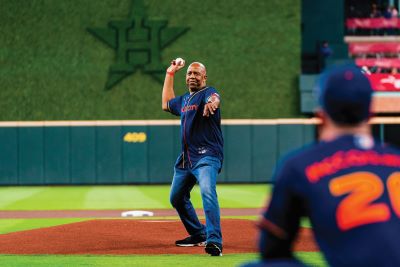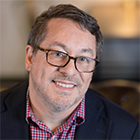When you become an astronaut, you join a very exclusive club.
Only 360 Americans have become astronauts, per the online fact book maintained by the National Aeronautics and Space Administration (NASA).
Bernard A. Harris Jr., MD, who wore a physician’s white coat before first donning a spacesuit, is in even rarer company.
On a spacewalk during a 1995 mission, he became the first African American to do so, joining an even more elite circle of 115 astronauts.
That unparalleled experience provided him with a perspective he’s taken into his work as an internist, philanthropist, author, and venture capital firm executive focused on advancing health care technologies.
He’s also a public speaker, a facet of his work he will exhibit as the featured speaker at the opening general session of TexMed, the Texas Medical Association’s annual conference, convening April 16-18, 2026. He’s titled his speech “An Astronaut’s Perspective: The Future of Medicine and Beyond.”
Though it focuses on the space-faring phase of his career, it will also draw from other elements of his remarkable life – including his current role investing in potentially transformative medical technologies, his considerable history practicing medicine, and his 40 years as a TMA member – with a curiosity about and love of science at the center of it all.
“Going around the Earth, surrounded by the Milky Way, knowing that there are over 300 billion galaxies in the known universe, and all of this operates within these laws which human beings only describe,” he told Texas Medicine. “We haven’t invented anything. We didn’t invent gravity. We didn’t invent all of the thermodynamics or electromagnetism or anything that you could think about in the history books – we’re describing what’s already there.”
In June 2025, 30 years after his initial spacewalk, Dr. Harris was inducted into the U.S. Astronaut Hall of Fame, placing him alongside Neil Armstrong, Buzz Aldrin, and Sally Ride in another elite group of astronauts, now 111 strong.
He was inspired throughout his childhood to look to the stars, even before the Apollo 11 moon landing in 1969 convinced him, at age 13, to chart a course for NASA. Born in Houston, he spent his first few years in The Heights – then considered a low-income neighborhood – before his parents divorced. Then, his mother got a job with the Bureau of Indian Affairs, and he moved out to Navajo Nation in Arizona and New Mexico.
“I moved from this inner-city environment to an environment where I could dream, and I would watch the lights open up the sky in the evening and wonder what it would be like to travel in space,” he recalled.
Rocketing toward medicine
Moving to San Antonio for his high school years, Dr. Harris embraced science – including joining Sam Houston High School’s Rocket Club – and inspired by his family physician, considered a career in medicine even though, as he put it, “NASA wasn’t far from my thoughts.”
“I put those two things together, and said I could be a medical doctor, practicing terrestrial medicine, and then as I joked, practice extraterrestrial medicine as a space medicine doctor,” he said.
But there was method behind the mirth, as he progressed from the University of Houston for his undergraduate studies, Texas Tech University Health Sciences Center for medical school, and the famed Mayo Clinic for an internal medicine residency, completing that training in 1985.
In 1987, a National Research Council fellowship in endocrinology at the NASA Ames Research Center put him on the path to becoming a NASA flight surgeon. During his NASA tenure, he also practiced medicine – first for community clinics run by the Baylor College of Medicine, and then with University of Texas Medical Branch as it was preparing to start an aerospace medicine program, which opened in 1993 and includes six astronauts among its graduates.
“My whole focus in the fellowship, and also the eventual research focus, was on bone loss. We lose 1% of bone per month in space,” he said. “I was instructed by a mentor that if I wanted NASA to recognize who I am and wanted to be of value to NASA, then I would find the most difficult problem, or one of the most difficult problems, to humans in space, and try to solve that.”
Dr. Harris notes that when human bodies travel in space and aren’t bound by the gravitational forces found on Earth, those bodies change significantly to adapt to their new surroundings.
“We lose about a fifth of our blood volume in space,” he said. “Our heart gets smaller. We lose about 10% to 20% of our muscle mass. We’re not able to fight off illnesses, we become anemic the longer we spend in space … and so we had to try to solve all of those problems if we were going to have people living and working in space. So that’s what I did for a couple of years.”

Dr. Harris was invited to the astronaut application process in 1990, selected to a 23-person cohort culled from more than 6,000 applicants. He then embarked on the year of basic training and two years of mission-specific training in advance of his first mission aboard the Columbia space shuttle in 1993.
That allowed him to experience firsthand those physiological changes he studied. He notes that upon returning from space, astronauts were made to wear a g-suit (an anti-gravity garment to keep blood from collecting in the lower extremities) and drink a liter of salt water before making their way back to terra firma, and were stretchered out of the space vehicle, rather than attempting to walk out, in order to aid recovery.
“We are cardiovascular deconditioned,” he explained. “So, if we stand up, we’ll pass out, because our circulatory system is not used to holding that blood against gravity.”
In total, Dr. Harris logged 438 hours in space; he recalls how disorienting it was the first time he left Earth to the space shuttle’s “cruising altitude” of 250 miles.
“I remember the main engines cut off, and now my checklist and things that were not tied down began to float up in front of me. That’s when you know that you’re really in space,” he said. “The first thing I wanted to do, of course, was to look out the window, press my head against it, and look down at Earth. And so, I opened the seat belt, and I popped out like toast out of a toaster, and I was just out of control kicking things, because this is the first time I’ve been in real zero gravity.”
While zero-gravity flights were part of Dr. Harris’ training, those airplanes only provide astronauts 30 seconds at a time to replicate what they’ll experience in space, compared to the two weeks he spent in microgravity on that first mission.
“I remember finally getting my space orientation, went up to the window, looked down like I naturally would, if you’re in an aircraft ... and Earth wasn’t down; it was up above me. So immediately I had to have this change of mindset. Everything’s relative.”
On Feb. 9, 1995, aboard the space shuttle Discovery, Dr. Harris got to experience space outside the confines of a space vehicle, seeing our world in a way few ever will.
“You see a sunset or sunrise every 45 minutes,” he noted, as it takes 90 minutes to fully go around Earth at the 17,500 miles per hour it requires to keep the space shuttle in orbit. “You could imagine opening up the hatch, looking out the porthole, and Earth is going by really fast. If you stare at it, you get a little dizzy until you get used to that movement.”
Reflecting on the remarkable episode in Embracing Infinite Possibilities, the book he published in February, Dr. Harris sees it now as a lesson in facing and overcoming one’s fears.
“As I prepared for my spacewalk, I felt a mix of excitement and fear,” he wrote. “One wrong move could mean catastrophe. But I reminded myself that fear is natural – it’s how we respond to it that matters. I focused on my training, trusted my abilities, and took that step into the unknown.”
Dr. Harris, past his days of venturing into space and practicing medicine, is currently chief executive officer of Vesalius Ventures, a venture capital firm which is, per its website, “dedicated to accelerating the future of medicine.”
With Vesalius, Dr. Harris has helped advance companies focusing in areas like ambulatory cardiac monitoring to better diagnose heart issues, and digital health care, a field he told Texas Medicine expands the capabilities of “what you would do in a traditional telemedicine setting.”
Since 1998, he’s also been involved with his Harris Foundation, based on the idea that for communities to advance, they need to be built on three pillars: education, health, and wealth.
The foundation focuses on science, technology, engineering, and math education for economically underserved communities.
Foundation programs have in the past included the Bernard Harris Summer Science Camp, a two-week residential camp for middle school students that was hosted by more than 50 colleges and universities across the nation throughout its history, and the Igniting STEAM program, in which participating students learned through investigating, designing, problem-solving, and self-expression.
His commitment to education is also reflected in having a school named for him – San Antonio’s Harris Middle School, which houses artifacts from his astronaut days, offers both a robotics class and after-school club, and uses “With hard work, there are no limits” as its motto.
Dr. Harris also treasures the opportunities he’s had to directly encourage others to learn. Be it the students he encounters who remember their time at his STEM camps years later, or the young physicians he guided in his Baylor College of Medicine and University of Texas Medical Branch days, he values mentorship and how it’s allowed him to positively influence lives.
“I get as much out of it as the students do,” he said. “I get energy.”
As Dr. Harris prepares to address the organization he’s stayed with through four decades at its largest annual gathering, he notes how integral it’s been in keeping him connected to medicine.
“I’ve known a number of the [physicians] in leadership through the years, and I think that TMA is so significant for physicians in Texas,” he said. “I keep up with policy and what’s happening with the state legislators through the periodicals and information newsletters that get sent out, so it’s a valuable tool for not only me but all physicians as we navigate these changing times in health care.”
Phil West
Associate Editor
(512) 370-1394
phil.west[at]texmed[dot]org

Phil West is a writer and editor whose publications include the Los Angeles Times, Seattle Times, Austin American-Statesman, and San Antonio Express-News. He earned a BA in journalism from the University of Washington and an MFA from the University of Texas at Austin’s James A. Michener Center for Writers. He lives in Austin with his wife, children, and a trio of free-spirited dogs.